How Can Axial Fans Support Natural Ventilation?
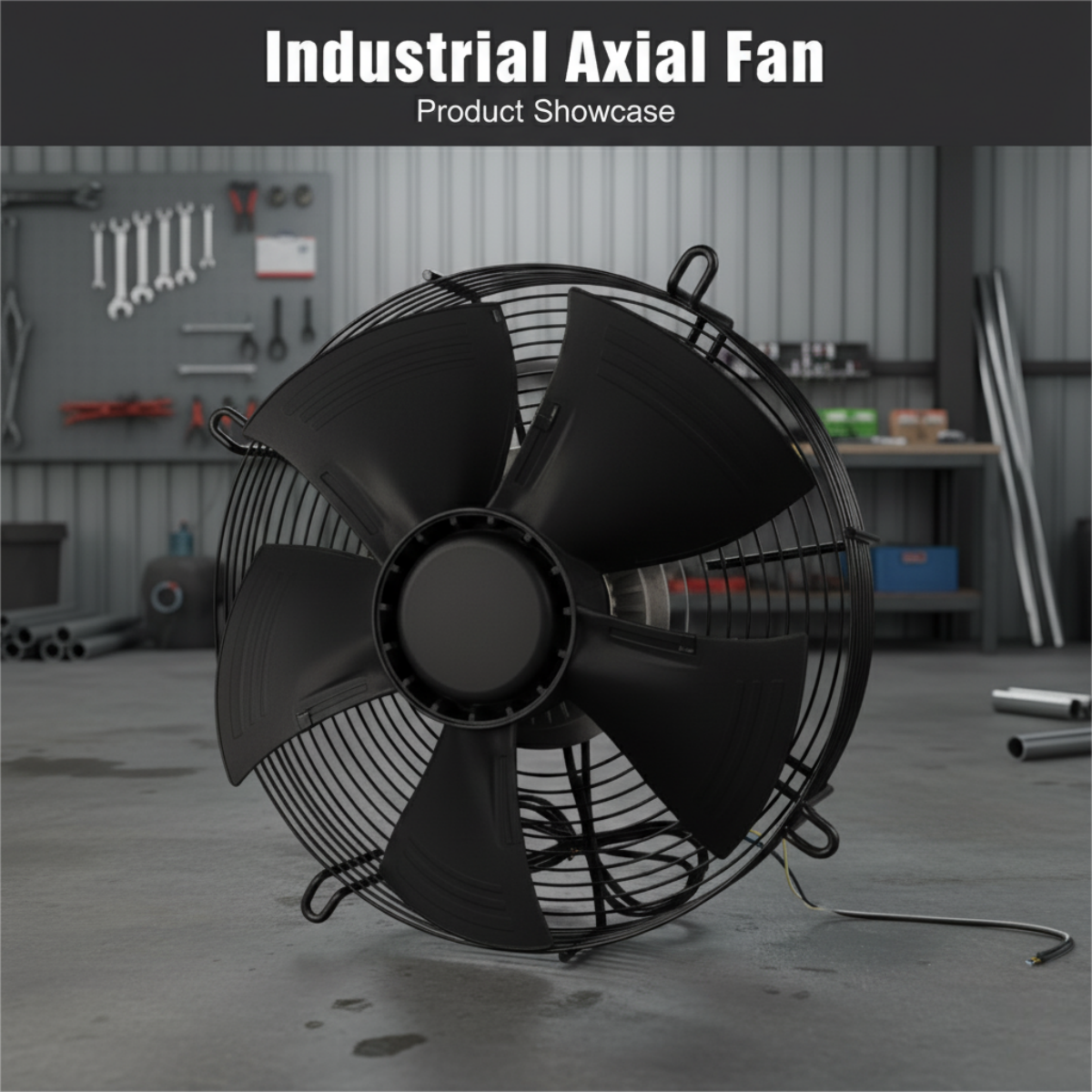
Axial fans, like the ones from Longwell, help move air fast. They make sure fresh air comes in and old air goes out. You can use them when wind or temperature changes do not give enough airflow.
"Many studies show that better air movement helps indoor air quality. It also helps people feel better inside. Research says people think air quality and comfort are better when air moves."
Using both kinds of ventilation can make your space healthier. It can also make it more comfortable.
Key Takeaways
Axial fans help make air inside better by bringing in fresh air and pushing out old air. This is important when natural ventilation does not work well.
Putting axial fans in the right place and picking the right ones helps air move better. This also makes rooms more comfortable.
Cleaning and oiling axial fans often helps them work better and last longer.
Using axial fans with natural ventilation can lower energy bills a lot. It also makes buildings more comfortable.
Picking the best type of axial fan for your needs, like AC, DC, or EC, can help them work better and save energy.
Natural Ventilation Basics
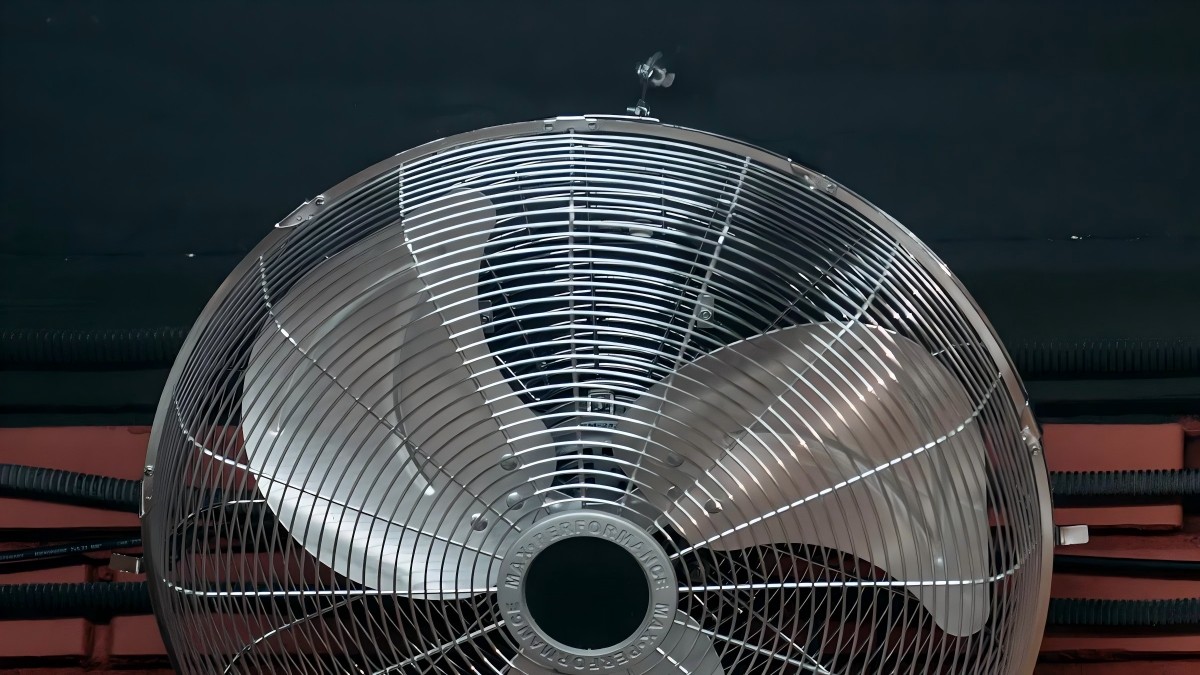
How Natural Ventilation Works
Natural forces can help move air inside buildings. Wind and temperature changes make this happen. Wind pushes air into the building through openings. Warm air goes up and leaves, which pulls in cooler air. You need both high and low openings for good airflow. Where you put these openings changes how air moves. The way the building faces is important too. If windows face the wind, more air comes in.
Here is a table that explains the main ideas behind natural ventilation:
Principle | Description |
|---|---|
Wind-induced ventilation | Wind pressure pushes air through building openings. |
Buoyancy-induced ventilation | Warm air rises and moves, which is called the 'chimney effect.' |
Importance of openings | High and low openings help air move and stop short-circuiting. |
Building orientation | The way the building faces changes how wind hits it. |
Fresh air exchange rate | This is how often air in the building is replaced to keep it clean. |
Studies show that good ventilation lowers indoor pollution. For example, classrooms with good windows have less carbon monoxide and carbon dioxide. You can read more about this in research from Nature and the EPA. Bringing in outside air helps get rid of bad stuff in the air.
Common Limitations
There are some problems if you only use natural ventilation. In tall buildings, air does not always move well between floors. Many buildings use machines to help because natural airflow is not always strong. Cold drafts from open windows can make people cold in winter. People close windows, and this makes air quality worse. In summer, heat waves make it hard to keep air fresh, especially in hot places. Bad air can make people feel sick and work less.
Here are some common problems:
Cold drafts in winter make people close windows, so air does not move.
Hot weather makes it hard to keep air fresh.
Tall buildings often need machines to help move air.
Bad air can hurt health and make it hard to work.
The weather and how the building faces are important too. If you design your building to catch the wind and block too much sun, you can save energy. Some studies say natural ventilation can cut cooling energy by half in cities.
Axial Fans in Ventilation Systems
How Axial Fans Enhance Airflow
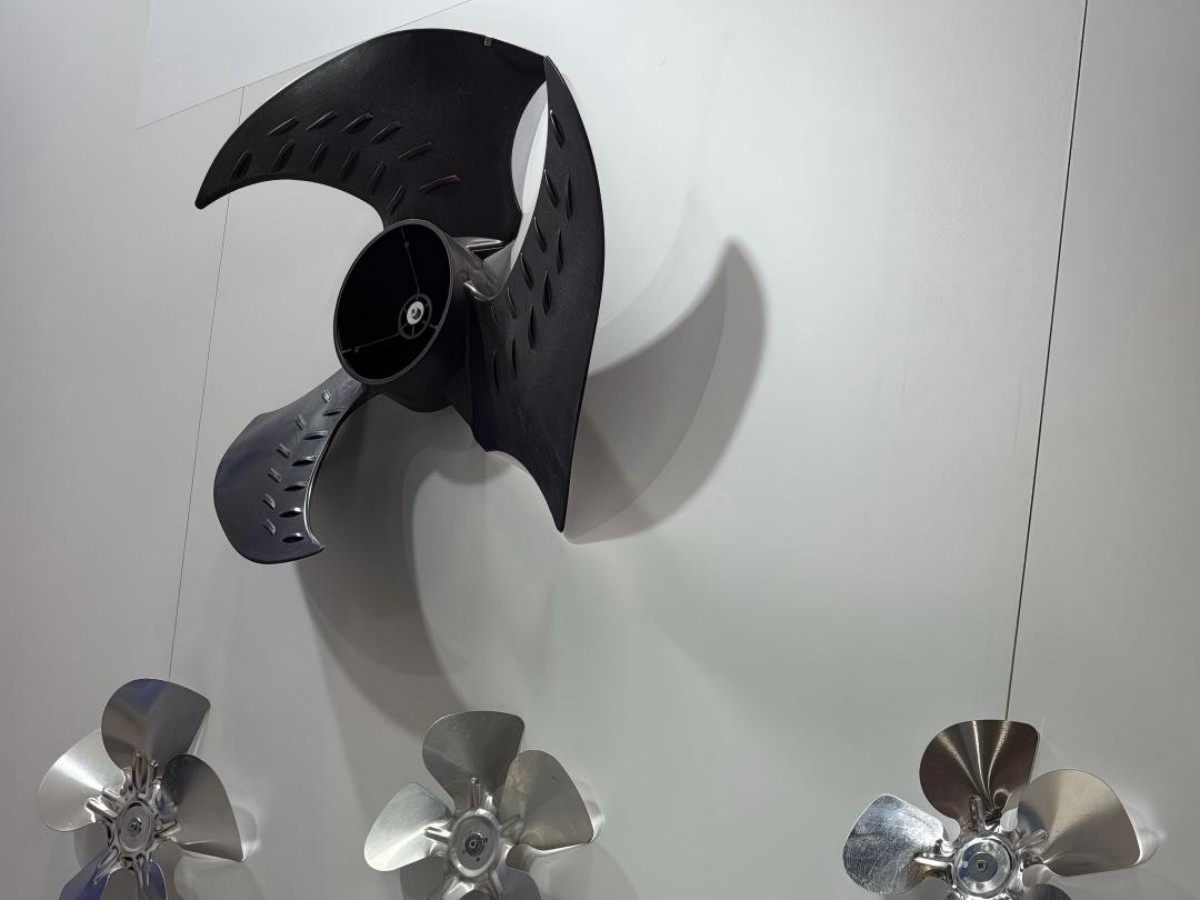
Axial fans help move air fast in many places. They pull air in and push it out in a straight line. This makes a pressure change that helps air move through rooms. Other fans push air to the sides, but axial fans send it straight through. This is why they are good for moving lots of air at low pressure.
Axial fans are small and fit in tight spaces or on walls. You see them in HVAC systems to keep air fresh and moving. If natural ventilation is not enough, these fans help keep indoor air clean.
Here is a table that shows how axial fans help when airflow is poor:
Feature | Description |
|---|---|
High Airflow Capacity | Axial fans move lots of air and can change how much air moves. |
Compact Design | Their small size makes them easy to put in many places. |
Applications | Used in HVAC systems to help air move and stay clean. |
Spot Cooling and Exhaust Functions
Axial fans do more than just move air. They can cool down machines, people, and rooms. If you put a fan near a hot machine, it brings in cool air and pushes out hot air. This keeps machines from getting too hot and helps workers stay cool.
Axial fans also take out bad air and bring in fresh air. This is important in places like kitchens, factories, and garages. They help remove fumes and dust so the air is safe to breathe.
Here are some ways to use axial fans for cooling and exhaust:
Move lots of air to cool electronics.
Bring in cool air and push out hot air to stop overheating.
Take out stale air to keep air clean.
Remove fumes and dust in exhaust systems.
Use in warehouses, factories, offices, and schools for air movement.
Use in paint booths, welding booths, kitchens, and auto shops for exhaust.
Cool spots with hot machines.
When to Use Axial Fans
Use axial fans when natural airflow is not enough. Some rooms do not get much wind or have few windows. In these places, you need fans to help move air. Axial fans work well deep inside big buildings, in closed rooms, or in small spaces with little heat. They also fit in rooms with low ceilings.
Here are some places where axial fans work best:
Deep inside big buildings
Closed rooms
Small spaces with little heat
Rooms with low ceilings
Adding axial fans helps every part of your building get fresh air. This keeps people healthy and comfortable when natural ventilation is not enough.
Types of Axial Fans
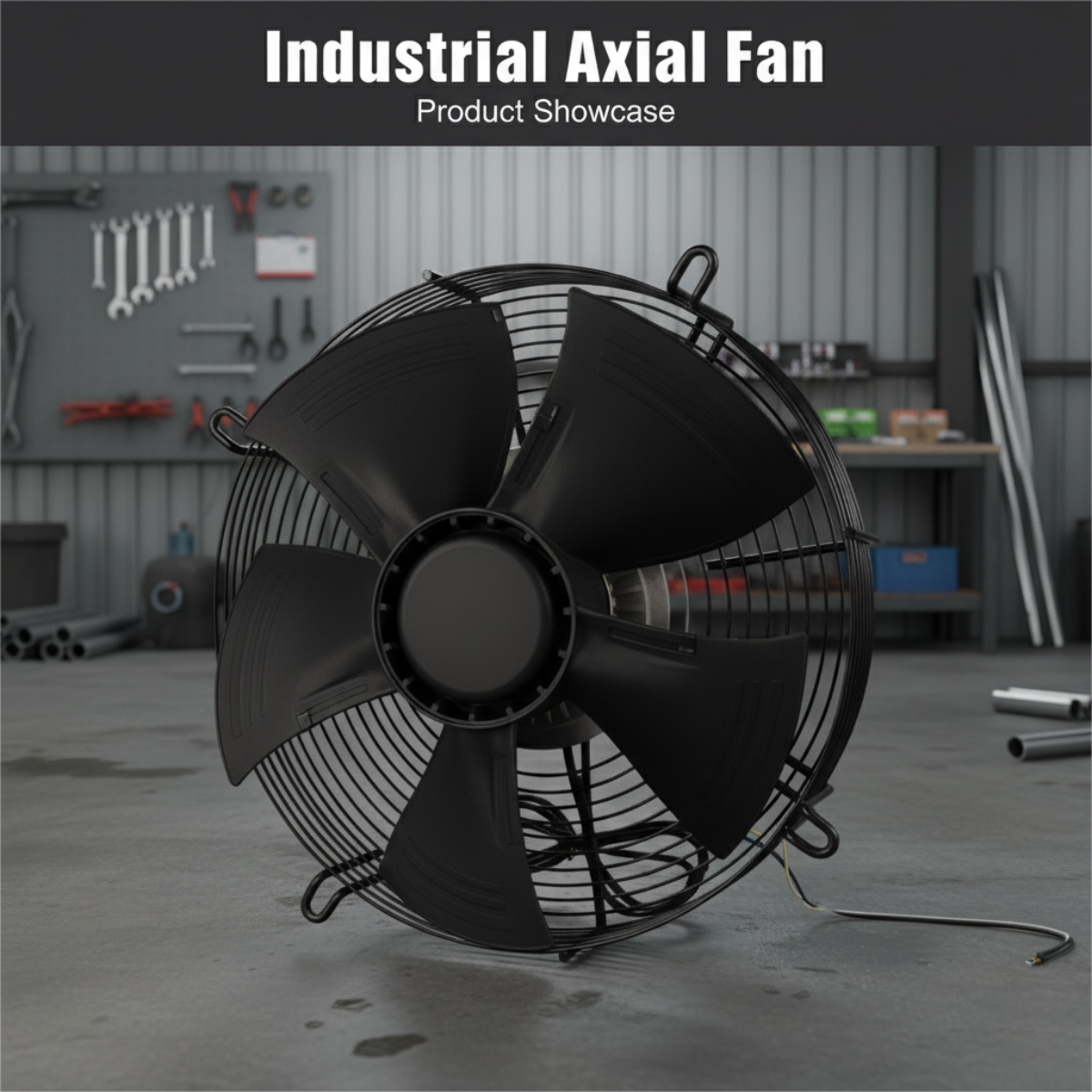
AC, DC, and EC Models
There are three main types of axial fans. These are AC, DC, and EC models. Each type has its own good points for moving air. AC fans use alternating current. They work well when you need strong and steady airflow. DC fans use direct current. They save energy and let you change the speed. EC fans mix the best parts of AC and DC fans. They use electronic commutation and brushless motors. EC fans can save up to 60% more energy than AC fans. You can control their speed with smart systems. You can also watch how they work in real time.
Here is a table that shows how these models compare:
Characteristic | AC Fans | DC Fans | EC Fans |
|---|---|---|---|
Efficiency Level | Lower (15%-50%) | Medium (~30% better) | High (75%-90%) |
Noise Level | Medium (50-70 dB) | Low (40-50 dB) | Very Low (30-45 dB) |
Control Flexibility | Fixed Speed | Flexible Speed | Intelligent, Remote Control |
Tip: EC fans help you save energy and make less noise. They are great for places where quiet is important.
Configurations and Materials
Longwell makes axial fans in many shapes and sizes. You can pick wall-mounted, ducted, or portable fans. The material you choose changes how the fan works and lasts. Stainless steel fans do not rust and can handle heat. They are good for tough jobs. Plastic blades cost less and work well with chemicals. Composite materials are strong but not heavy. Aluminum and steel fans are good for most jobs and save money. For very hot places, ceramic and special alloys work best. Non-ferrous materials stop sparks in places with flammable gases.
Here is a chart that shows which materials fit different environments:
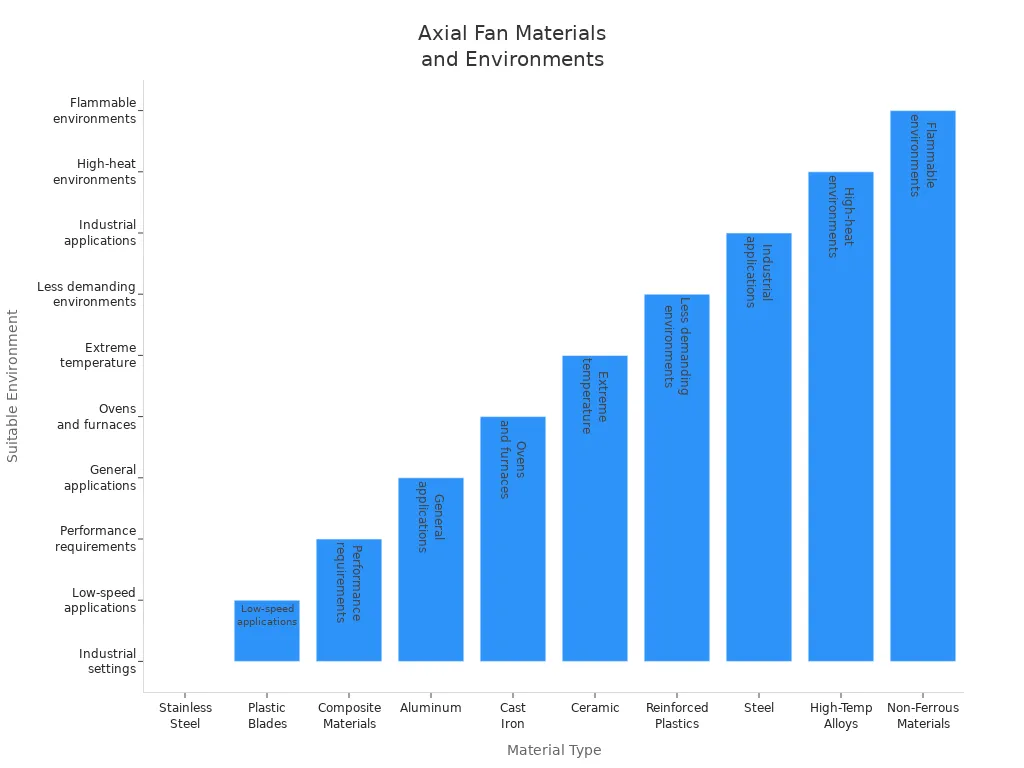
Axial fans usually make noise between 35 and 45 dB(A) in open air. Some fans can move up to 220 CFM of air with a pressure of 75 Pa if you need more airflow.
Application Scenarios
You can use axial fans in many places. In big buildings, they help move air in large rooms and lobbies. In factories, they cool machines and take away fumes. Farms use them in greenhouses and poultry houses to keep air fresh. Data centers use them to stop computers from getting too hot.
Here is a table with common uses:
Application Scenario | Description |
|---|---|
Building Ventilation | Moves air in big rooms, atriums, and lobbies |
Cooling Systems | Keeps industrial equipment cool in towers and chillers |
Exhaust Systems | Removes stale air, fumes, and smoke from work areas |
Agricultural Settings | Maintains airflow in greenhouses and poultry houses |
Data Centers | Prevents overheating by moving large volumes of air |
Longwell’s axial fans work in many places. You can put them on walls, ceilings, or floors. They meet global standards and run quietly. This makes them good for offices, factories, and cleanrooms.
Integrating Axial Fans with Natural Ventilation

Selecting the Right Fan
Choosing the best fan for your ventilation system starts with understanding your needs. You should look at the size of your space, the number of people inside, and the type of work happening there. Each area may need a different amount of airflow. To help you make the right choice, consider these important points:
Know your specific needs for airflow and pressure.
Check the performance of each fan, such as how much air it moves and how much energy it uses.
Plan where to put each fan based on the shape and size of your space.
You can use special tools to help you pick the right fan. Some companies offer AI-powered software that finds the best fan for your building. These tools use real-time data to adjust their suggestions if your needs change. They also help you find fans that save the most energy. You can use aerodynamic duty-based selections, performance modeling, and even BIM or REVIT tools to see how the fan will work in your building. These resources make it easier to match the right fan to your natural ventilation project.
Tip: Using fan selection software helps you avoid mistakes and saves time when planning your ventilation system.
System Design and Placement
Good design and placement of axial fans make your ventilation system work better. You need to think about where to put each fan so that air moves smoothly through your building. If you place fans in the wrong spot, you might not get enough fresh air or you could create pressure problems.
Here are some common mistakes to avoid:
Forgetting to check and seal ducts, which can cause air leaks.
Using dampers the wrong way, which can block airflow.
Measuring airflow in the wrong place, leading to bad results.
Ignoring return vents, which can upset the balance of air.
Not adjusting fan speed for different needs.
Not thinking about changes in how the space is used.
Failing to keep good records of changes.
Overlooking design problems in the system.
Studies show that when you place axial fans correctly, you can get better airflow and cleaner air inside. Some research uses computer models to test different fan setups. These tests show that the right fan in the right place can move air faster and make living spaces more comfortable, especially when you match fan height with window height.
Longwell offers many types of axial fans, including EC and DC models. You can choose from different sizes and designs to fit your needs. If you need help, Longwell’s experts can guide you to the best fan for your building.
Maintenance and Efficiency

Keeping your fans clean and well-maintained helps them last longer and use less energy. You should follow a regular maintenance routine to make sure your fans work their best. Here is a table that shows what you should do:
Maintenance Task | Importance |
|---|---|
Regular cleaning | Stops dust and dirt from blocking airflow and keeps the fan efficient. |
Proper lubrication | Makes sure moving parts work smoothly and last longer. |
Performance monitoring | Helps you find problems early and keep the fan working well. |
You should also check and clean the fan blades, hub, and inside the housing. Tighten bolts and electrical connections. Listen for strange noises and watch for shaking. Clean the blades often to stop dust from building up. Lubricate the bearings to reduce friction and help the fan last longer.
Regular cleaning and inspection prevent the fan from losing efficiency. This also helps the fan last longer. Focus on the blades, housing, and ducts to remove dust and debris. Always follow the manufacturer’s advice for maintenance.
Note: Longwell provides technical support and expert advice to help you keep your fans running smoothly. You can ask for help with choosing, installing, or maintaining your fans. Longwell also offers custom solutions to fit your special needs.
You can use axial fans, like those from Longwell, to boost natural ventilation in many settings. These fans help you move fresh air where it is needed most. To get the best results, you should:
Check your airflow needs and the space where you will use the fan.
Pick fans that match your noise and temperature limits.
Make sure the fan fits the pressure level of your system.
Keep your fans clean and check them often.
When you follow these steps, you create a healthier and more comfortable space. If you need help, Longwell’s experts can guide you to the right solution.
FAQ
What is the main benefit of using axial fans with natural ventilation?
Axial fans help bring in more fresh air. They make indoor air cleaner and better to breathe. These fans work when wind or temperature changes are not enough. This helps people feel healthier and more comfortable inside.
How do you choose the right axial fan for your building?
First, look at how big your room is. Think about how much air you need to move. Check if you need the fan to be quiet. You can use special tools or ask experts for help. Longwell can help you find the best fan for your space.
Can you use axial fans in humid or dusty environments?
Yes, you can use them in places with lots of moisture or dust. Longwell makes fans that keep out water and dust. These fans work well in bathrooms, factories, and other hard places.
How often should you maintain your axial fans?
You should clean and check your fans every few months. Doing this helps the fans work well and last longer. Always follow what the maker says for taking care of your fans.
See Also
A Comprehensive Guide to Axial HVAC Fans Today
Why Efficient Axial Fans Are Ideal for Today's Ventilation
Exploring Performance and Energy Efficiency of Axial Fans